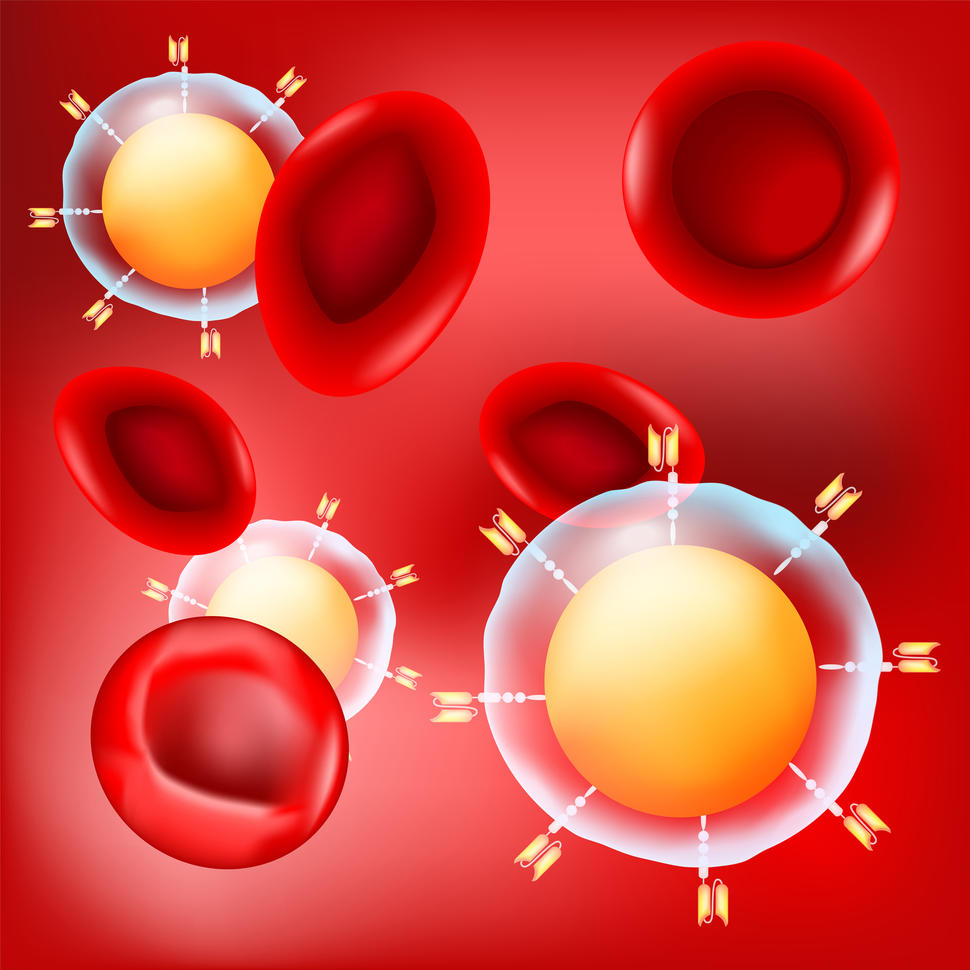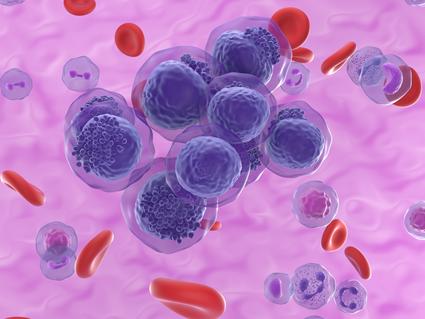Stealing Strategies from Cancerous T Cells May Boost Immunotherapy
, by Sharon Reynolds
For some people with blood cancers like leukemia and lymphoma, CAR T-cell therapies have proven to be a transformative treatment. But for solid tumors like breast, colorectal, or pancreatic cancer, which make up about 90% of cancer cases, success with T-cell therapies has been harder to come by.
One big reason for these failures is that T cells, the immune system’s primary defense against infected and diseased cells, often become weakened and incapacitated in the toxic environment found within and around solid tumors. Researchers have been exploring many ways to help CAR T cells and other experimental T-cell therapies survive within these hostile surroundings, known as the tumor microenvironment.
In a new study, an NCI-funded research team showed the promise of one such tactic: looking to the genetic changes that cancerous T cells themselves use to stay alive and grow. Incorporating those genetic changes into T-cell therapies, the team found, may make them better cancer killers.
When tested in mice, T cells engineered to have one specific genetic alteration the team discovered in cancerous T cells gave the engineered cells “superpowers,” said Jaehyuk Choi, M.D., Ph.D., of Northwestern University, who co-led the study.
Adding the genetic change, a fusion of parts of two genes, helped the engineered T cells divide faster, kill more tumor cells, and survive for more than a year in the treated mice. And, importantly, it didn’t make the T cells behave like cancer cells, the researchers reported February 7 in Nature.
“When we added [this] single mutation, we didn’t see the sort of unrestrained [T-cell] growth [you see in cancer], but it gave [the engineered] T cells capabilities that they don’t naturally have,” explained the study’s other leader, Kole Roybal, Ph.D., of the University of California San Francisco.
The first two decades of T-cell therapy research focused on the basics, explained Rosa Nguyen, M.D., Ph.D., who studies cellular therapies in NCI’s Center for Cancer Research but was not involved in this study. That work included figuring out what molecules on cancer cells can be targeted by T cells and how to change T cells to better identify such targets, as is done in CAR T-cell therapies.
“Now people are getting super creative in coming up with different things [to add] to these cells to make them work better,” Dr. Nguyen said. “That’s what the field is moving toward now.”
Harnessing nature’s survival strategies
Any type of cell in the body has the potential to turn cancerous, even immune cells. As its name implies, the blood cancer called T-cell lymphoma starts in T cells.
These cancerous T cells have something many normal T cells often lack: the ability to thrive in the hostile environment of a tumor. That environment can include other immune cells that actually work to slow down or disable T cells, as well as other cells and molecules that make it hard for T cells to function.
Dr. Choi’s lab has been studying the survival traits of T-cell lymphomas for over a decade. “It’s … amazing how these T-cell cancers have developed ways to protect themselves,” he explained.
From the perspective of developing a T cell–based therapy, many of the mutations found in cancerous T cells provide an additional advantage, Dr. Choi explained: Any one of them, on its own, is not likely to direct a cell to become cancerous.
Their years of research clearly showed that “nature has already done this massive experiment to make [cancerous] T cells stronger,” he explained. So “we thought maybe [nature] can show us the way” to improve T-cell therapies.
Better, faster-acting, and safe T cells
Joining forces with Dr. Roybal’s lab, which specializes in T-cell engineering, the researchers first carefully analyzed a wide range of cancerous T cells from T-cell lymphomas, looking for genetic alterations that appeared to help them survive in that tumor microenvironment.
They initially found 71 candidate alterations. In further laboratory experiments, they engineered CAR T cells to have some of the most promising candidate alterations, and this achieved what the researchers had hoped: They increased the CAR T cells’ ability to kill cancer cells and keep creating more CAR T cells.
Additional work revealed what appeared to be the most promising alteration: a fusion of parts of two genes, CARD11 and PIK3R3.
“This single [fusion] activated many things that people have predicted would help [improve] T-cell therapies,” Dr. Choi explained. In experiments in mice, treating them with CAR T cells engineered to express this fusion gene increased the production of molecules that T cells need to survive and function.
And these improvements only occurred when the specific protein recognized by the T cells’ specialized receptor, their chimeric antigen receptor, was present. That is, these extra-engineered CAR T cells would only become supercharged where and when needed inside a tumor.
Improved T cell survival and persistence in solid tumors
The team tested the CAR T cells engineered to express the gene fusion in mouse models of different cancers, including solid tumors like mesothelioma and melanoma. Across those experiments, they found that the treatment was much more effective at shrinking tumors—and keeping them under control for longer—than CAR T cells without the fusion.
“Persistence, the ability to stick around in the tumor microenvironment, is the biggest problem [these cells] solved,” Dr. Choi said. While T cells without the fusion died within a few days, the ones with the fusion “seem to stick around for as long as needed,” he said.
The treatment was very effective even though the mice didn’t also get chemotherapy, Dr. Choi pointed out. That is important because currently, “almost everyone who gets treated with [T-cell therapies] needs to have what’s called conditioning chemotherapy beforehand,” Dr. Choi explained. But this chemotherapy can cause side effects, often severe enough that patients have to wait longer to get the T-cell treatment or possibly preventing them from doing so at all.
“If we ever want these sorts of therapies to be given in less specialized centers, or even in the outpatient setting, we need to get rid of these cumbersome techniques [like conditioning chemotherapy] that are toxic to patients,” added Dr. Roybal.
The researchers also engineered the fusion into a different type of T cell–based immunotherapy, called TCRs, and saw similar results.
In a mouse model of melanoma, for example, TCR T cells with the fusion gene flowed into tumors in much greater numbers and killed tumor cells much more effectively than TCR T cells without the fusion gene. The TCR T cells with the fusion even showed this advantage at starting doses 20 to 100 times lower than TCR T cells without the fusion.
Being able to give a lower dose of a T-cell therapy would provide another safety advantage for patients, Dr. Roybal explained. Current CAR T-cell therapies, which are given in large doses, have the potential to cause a dangerous—or even fatal—immune system overreaction called cytokine release syndrome. That risk would likely be lower with a smaller dose that ramps up its activity over time, he added.
The researchers also tracked the T cells in the mice for more than 400 days after treatment. Though they initially multiplied rapidly to kill the tumors, their numbers then shrank back down and showed no signs of becoming cancerous themselves.
Testing supercharged T cells in people
The researchers have launched a biotechnology startup to move their CAR T-cell therapy with this gene fusion into human trials, although they are likely 2 to 3 years away from launching these studies, Dr. Roybal explained.
Eventually, researchers may want to try mixing and matching different ways to soup up T cells, Dr. Nguyen said. But these approaches first need to be tested one at a time to better understand how each one works. “We have to use a stepwise approach,” she said.
Drs. Roybal and Choi also want to keep exploring the dozens of other promising mutations their screen initially uncovered.
“We found a lot of different mutations … that could [potentially] be used” in T-cell therapies to treat “a variety of different types of cancer,” said Dr. Roybal.
“Maybe the [CARD11–PIK3R3] fusion protein will be good for [fighting] some subset of solid cancers. And one of the other [mutations] we found will be important for another subset,” he said. “This is the beginning [of this research], not the end.”


